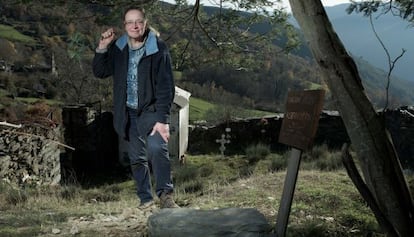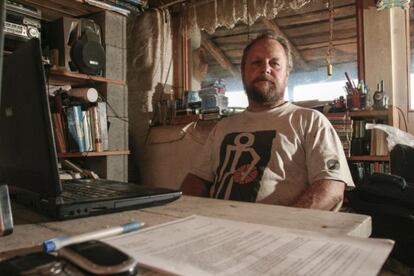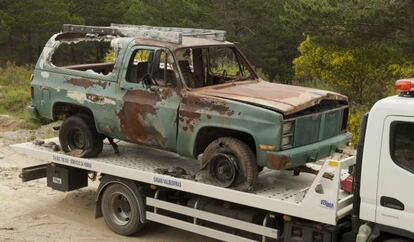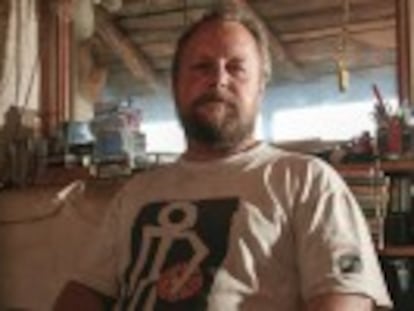Life and death in the hills of Galicia
Margo Pool’s husband was murdered in the abandoned village of Santaolla But the Dutch widow of Martin Verfondern says she will spend the rest of her days there

Until last summer, there were just six registered inhabitants in Santaolla do Monte, an all-but abandoned village located high up in the hills of Galicia’s Ourense province. They were Dutch couple Margo Pool and her husband Martin Verfondern, who moved there 17 years ago, and the Rodríguez family, made up of a couple now in their eighties and their two sons: Julio and Carlos. But Carlos, who has an intellectual disability of 70 percent, is now in prison awaiting trial after confessing to killing Martin Verfondern in January 2010.
The remains of Verforndern, who would be 57, were found by police on June 21, located by his partially burnt-out car in a remote patch of woodland some 12 kilometers away from the village. The motive for the murder, if Carlos Rodríguez’s confession is true, was a court ruling in Verfondern and Pool’s favor over a long-standing dispute involving the grazing rights for 350 hectares of common land spread across the hills that surround the village.
Via video recordings, Verforndern documented the “rural terrorism” he encountered every day
Via a number of video recordings, Verforndern documented the “rural terrorism” that he encountered every day from his neighbors, and predicted his own death at the hands of the Rodríguez family. Margo Pool is aware that the murder of her husband has made headlines around the world, and is also aware that people who have read the story ask themselves how it’s possible she continues to live alone with her enemies in the village, which was abandoned decades ago by the rest of its inhabitants and whose former homes are in various states of collapse.
“I am not afraid, and I’m happy here,” she explains. “Martin lives on in my heart, he’s with me. This life was our project, and now I have to continue with it. What’s more, if I were to leave, they would win the war that my husband died for.”
Verfondern and Pool had moved to Santoalla from the Netherlands in 1997 after marrying and quitting their office jobs in Amsterdam in search of “the cleanest air and the purest water in Europe.” Once in the village, they set up the Centro Ammehula organic farm, which for a few years attracted backpackers from around the world who were looking to get back to nature during the summer months.
Initially, Verfondern and Pool got on well with their new neighbors, but as the years passed they fell out over the grazing rights on the huge hillside that overlooks the village, despite a judicial ruling in favor of Verfondern, who described the octogenarian Rodríguez as a “fascist” patriarch akin to Saddam Hussein overseeing a vast clan.

Verfondern also fell out with the community’s mayor, Miguel Bautista of the Socialist Party, due to his complaints about the lack of amenities in Santoalla, and particularly the damage that an open-air refuse site was doing to the water table and a nearby stream he used to water his goats and sheep.
A member of Amnesty International, Verfondern described the tense relationship he endured with his neighbors, saying that he was constantly provoked and threatened. He reportedly came to blows with the elder Rodríguez on several occasions.
Verfondern and Pool got on well with their new neighbors, but as the years passed they fell out over the grazing rights
The last time anybody saw Martin Verfondern alive was on January 19, 2010, when he left Santoalla in his battered Chevrolet pick-up truck to do his weekly shopping in the nearest town, Petín, some 15 kilometers away.
Police say he was killed by a gunshot wound to the head and his body was then taken to a pine wood a little over 20 kilometers away along unpaved forest roads. His car was set alight, his belongings scattered, and his body left out in the open.
He was eventually discovered by Civil Guard officers flying over the area in a helicopter more than four years later.
Verfondern’s remains were handed over to Pool by the authorities in a cardboard box, and now lie partially buried under a slab of slate in the tiny, overgrown churchyard in Santaolla. “It’s all been very strange. I never imagined that I would have to dig my husband’s grave,” says Margo Pool.

“Martin was survived by his mother and three siblings. They want to take his remains to the Netherlands to cremate them, and then spread them between Germany, where he was born, Holland, and in Petín. He didn’t really care what happened to him after he died. But his spirit will be here forever,” explains Pool.
When Verfondern’s ashes are finally scattered, Pool says she will place a sign overlooking the vast valley that spreads out below her home saying: “Here grows Martin, the Dutchman from Petín”. The sign will be carved by José, a friend who now lives in a caravan in Petín after spending a summer with the couple a few years ago.
Police say he was killed by a gunshot wound to the head and his body was then taken to a pine wood
“I too would like to die here, but in my own time,” says Pool as she picks her way through the ruins of the village. “What I don’t know is how I will get on when my eyes start to go. I can’t see out of my left eye, and now I’m worried about the other.” Nevertheless, Pool seems resigned to spending the rest of her days accompanied by her goats in this wild and out-of-the-way spot: “I wouldn’t leave for the world; but it’s also true that I don’t really have much option; I’ve no money,” she explains.
She and Verfondern invested all their savings in buying their house in Santaolla in 1997. Since then, they have survived by working part time and by selling their goats: “I try to avoid killing them myself, but I have to live,” she says. Pool’s limited income is also boosted by her Dutch early-retirement pension. But even if she decided to leave, she would find no buyer for her house and two other, ruined, properties in Santaolla. Her only family in the Netherlands is her 89-year-old mother, whom she visits twice a year: “At Christmas and on her birthday, in June.” Her elder brother died three years ago, she says, leaving her a little money that enabled her to buy a small van and a wood-burning stove to help her survive the long, cold winters of Santaolla, where soon, she may be the only inhabitant.
Tu suscripción se está usando en otro dispositivo
¿Quieres añadir otro usuario a tu suscripción?
Si continúas leyendo en este dispositivo, no se podrá leer en el otro.
FlechaTu suscripción se está usando en otro dispositivo y solo puedes acceder a EL PAÍS desde un dispositivo a la vez.
Si quieres compartir tu cuenta, cambia tu suscripción a la modalidad Premium, así podrás añadir otro usuario. Cada uno accederá con su propia cuenta de email, lo que os permitirá personalizar vuestra experiencia en EL PAÍS.
¿Tienes una suscripción de empresa? Accede aquí para contratar más cuentas.
En el caso de no saber quién está usando tu cuenta, te recomendamos cambiar tu contraseña aquí.
Si decides continuar compartiendo tu cuenta, este mensaje se mostrará en tu dispositivo y en el de la otra persona que está usando tu cuenta de forma indefinida, afectando a tu experiencia de lectura. Puedes consultar aquí los términos y condiciones de la suscripción digital.
More information

Dutchman’s shooters: “I’m going after you. You’re fat and ready for killing”
Últimas noticias
The complicated life of Francesca Albanese: A rising figure in Italy but barred from every bank by Trump’s sanctions
How Japan is trying to avert ‘digital defeat’
Half of Scotland is in the hands of 420 property owners
Reinhard Genzel, Nobel laureate in physics: ‘One-minute videos will never give you the truth’
Most viewed
- Pablo Escobar’s hippos: A serious environmental problem, 40 years on
- Reinhard Genzel, Nobel laureate in physics: ‘One-minute videos will never give you the truth’
- Why we lost the habit of sleeping in two segments and how that changed our sense of time
- Charles Dubouloz, mountaineering star, retires at 36 with a farewell tour inspired by Walter Bonatti
- The Florida Keys tourist paradise is besieged by immigration agents: ‘We’ve never seen anything like this’








































